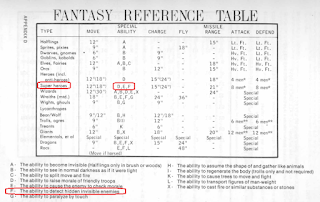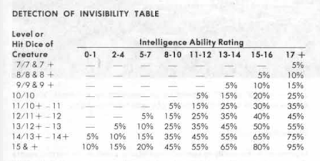Consider the O/AD&D Superhero -- a.k.a, the 8th-level Fighter. If you blink you'll miss it, but in multiple places in early texts it says that fighters of that level can automatically see invisible enemies. (!)
Here's the Fantasy Reference Table from the Chainmail game (included by reference in multiple parts of Original D&D), with key parts highlighted:
Now, you might possibly think that's a typo or something, except that it gets restated in Original D&D, Vol-2 (the Monsters & Treasures booklet), specifically in the entry for Pixies:
PIXIES: Air sprites as described in CHAINMAIL, Pixies can be made visible, or make themselves visible, but they are naturally invisible to human eyes. Therefore, they are able to attack while remaining generally invisible. They can be seen clearly only when a spell to make them visible is employed, although certain monsters such as Dragons and high-level fighters will be aware of their presence.A few years later, the Advanced D&D game generalized this ability, such that any high-level creature had some chance of detecting invisible. However, the chances of success are much reduced. For example, the 8th-level Superhero fighter now needs a very high Intelligence score, specifically 15 or higher, to have even a 5% chance of detecting invisible in a given round. Here's this table from the 1E DMG p. 60:
This seems like an odd rule: counterintuitive, easy to forget, unlikely to come into play in most games. And under the interpretation seemingly shared by the earliest designers -- that OD&D and AD&D were a single continuous game undergoing some evolution -- this seems like a case where Gygax was quickly becoming disenchanted with the rule; radically dialing down the likelihood for standard high-level fighters, for example. I take this as evidence that the clear intent was to largely take the ability away from standard Superheroes after some amount of playtest experience in D&D. (And of course this general rule was sufficiently fragile that it disappeared in later editions.)
Separately: As usual for O/AD&D, if you disentangle the numbers in that 1E table, you'll find that the progression on each axis is mostly linear. You could get a good approximation of that rule by doing the following:
Roll 1d20 + Level + Intelligence and score 40 or more.Or in Target 20 terms: roll d20 + Level + Intelligence - 20 and get a total of at least 20.
But would you want to use such a rule?




